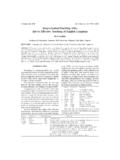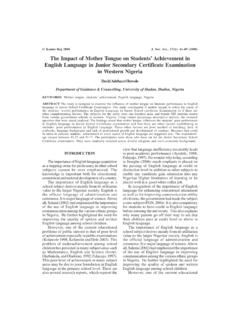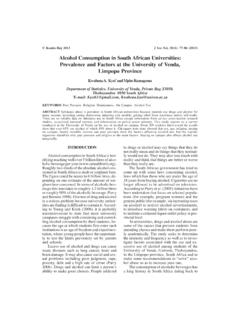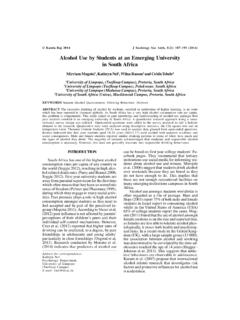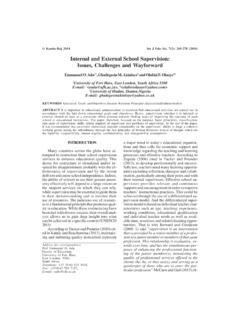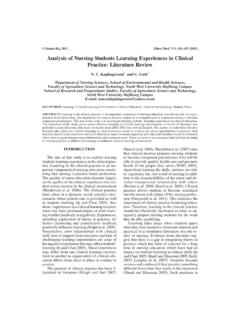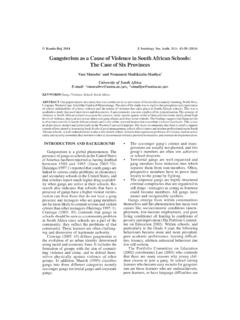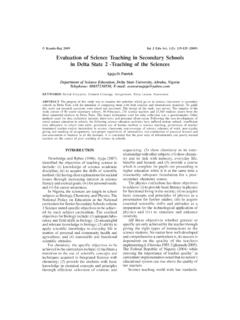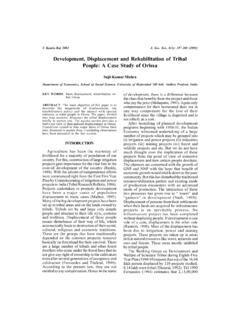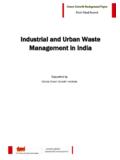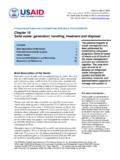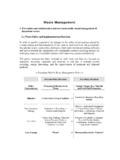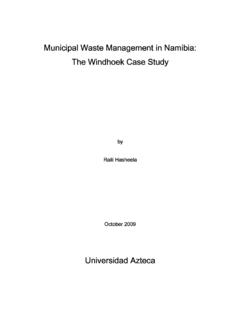Transcription of Challenges and Opportunities in Municipal Solid …
1 Kamla-Raj 2011J Hum Ecol, 33(3): 179-190 (2011) Challenges and Opportunities in Municipal Solid waste management :The Case of Addis Ababa City, Central EthiopiaNigatu Regassa 1, Rajan 2 and Bizunesh Bogale Seboka21 Institute of Environment, Gender and Development, Hawassa University, 679, Hawassa, SNNPR, Ethiopia1E-mail: negyon Phone: 251-046-2206975 2 Department of Rural Development and Agricultural Extension,Haromaya University, EthiopiaKEYWORDS waste . management . Disposal. Re-use. Addis AbabaABSTRACT Solid waste , which is a consequence of day-to-day activity of human kind, needs to be managed properly.
2 AddisAbaba, like other cities in developing countries, faces problems associated with poorly managed Solid waste operation. Thisstudy deals with analysis of the city s current Municipal Solid waste management problems, Opportunities and existing solidwaste management practices. The survey was conducted in Bole and Akaki Kality sub-city. Different sampling methods wereemployed to select the study units including: stratified sampling, systematic random sampling, and purposive sampling. Thoughthe bulk of the data collected were qualitative in nature, it was also supported by quantitative information collected throughsurvey and secondary sources.
3 The study revealed that the reasons for low performance of SWM in the city includes:inaccessibility of the city due to the geographical and urban structure, lack of properly designed collection route system andtime schedule, inadequate and malfunctioning operation equipment, open burning of garbage, poor condition of the final dumpsite, littering of the corner around the skips which encouraged illegal dumping are the technical problem identified. Insufficientfunds as well as lack of promotion on- waste reduction: recycling, absence of cost recovery, practice of energy option, wasteseparation and composting are among the financial challenge.
4 Social problems encountered include: lack of publicawareness,illegal dumping, poor condition of waste workers, lack of private sector and community involvement. Incompetenceof organizations in terms of equipment required for operation and man power /staff qualifications, training and human resourcedevelopments/ and unreliable service are the institutional challenge that the city encountered in the sector. Finally, the studyforwarded some important recommendations towards improving the BACKGROUNDD ealing with the environmental costs in rap-idly growing economic development, urbaniza-tion and improving living standards in citieshave led to an increase in the quantity and com-plexity of generated waste , representing a phe-nomenal challenge (UNDP 2004).
5 This is par-ticularly true in the area of Solid waste manage-ment. While cities are generating an ever-in-creasing volume of waste , the effectiveness oftheir Solid waste collection and disposal systemsare declining. In urban centers throughout Af-rican regions, less than half of the Solid wasteproduced is collected, and 95 percent of thatamount is either indiscriminately thrown awayat various dumping sites on the periphery ofurban centers, or at a number of so-called tem-porary sites, typically empty lots scatteredthroughout the city (Mohammed 2003).
6 Addis Ababa city started its Solid waste man-agement some three decades back. The servicecannot meet changing demands. The socialwaste collection service is unsatisfactory, andscenes of scattered waste are common in mostpart of the city (UNDP 2004). As a result, thepopulation has the opinion that the municipalsolid waste collection service is not functioningproperly. As a result of this, the willingness ofthe population to cooperate with waste collec-tion operation and to pay for the service is respect to the organization of operationsand management structure, collection and dis-posal are parts that are poorly organized.
7 A dis-posal site situated at one corner of the city isalso the main determining factor for collectionand disposal of wastes in the city. This meansthat it is only those people close to the dumpsitesthat benefit. Dump sites and trucks for solidwaste disposal are insufficient. In densely popu-lated Kebeles, the majority of people live km from accessible roads where transfercontainers are located, when the recommendeddistance is 150 m from the housing units(Zerayakob 2002). Solid waste collected fromhospitals, residential and business areas isdumped at the landfill sites on the outskirts ofthe city.
8 It is common to find refuse pileup atroad intersections or strewn in open context to processing and recycling ofsocial waste , little is done at all level of its man-agement there is no source separation orsorting and this happens at disposal sites some scavengers at landfill sites practicean informal type of waste recovery. Other op-tions like energy recovery and composting arenot practiced as alternatives for waste of the waste is administered by the gov-ernment with no or little involvement of pri-vate sectors and tends to be costly and ineffi-cient (ENDA 2006).
9 Some communities receivelittle (in some cases no) Solid waste collectionservices because local governments have no re-sources to cover all households. Thus, in theabsence of collection services, households useforms of disposal most of which are heavily pol-luting. According to ENDA (1999), the city hasa limited sewerage system, designed for 200,000households, but presently covering only on the composition, volume and weightof Solid waste generated and collected in AddisAbaba carried out in early 1980s and mid 1990sby Nure consultancy with the support of LouisBerger Company indicates that the estimates ofwaste generated per capita per day varies involume from to lit/capita/day, in weightfrom to kg/capita/day and in densityfrom 205 to 370kg/m3 (MAA 2002.)
10 Yami 1999).In other studies, the daily waste generation isestimated to be (AASBPDA2003). Regardless of increasing volume of wastegenerated, the performance of the city s solidwaste collection and disposal system is poor(WHO 1996). Currently only 65% of the solidwaste produced per day is collected and disposedby the municipality in the dumpsite, 5% is re-cycled, 5% is composted and the remaining 25%of the Solid wastes are uncollected and dumpedin unauthorized areas such as open fields,ditches, sewers, streets and many other avail-able spaces in the city (AASBPDA 2003).
